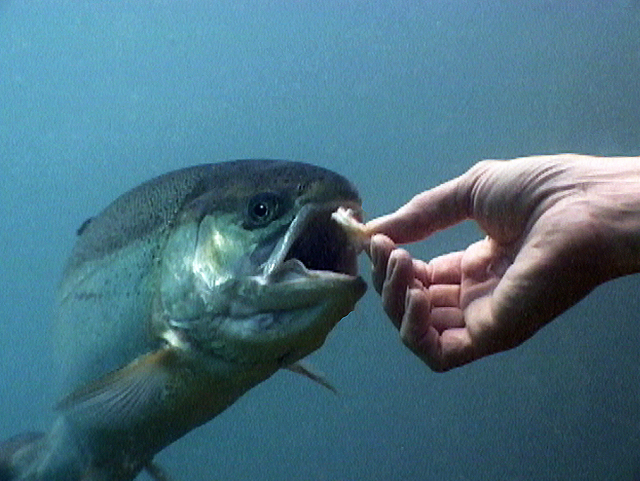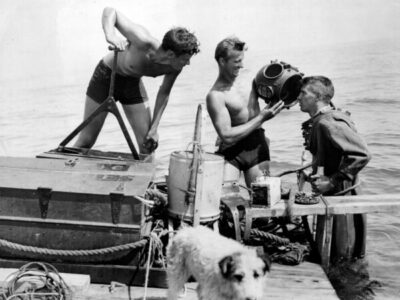
In the spirit of yuletide reminiscing, I recently found myself looking back at my journey to bringing more freshwater fish content to PBS audiences. One particularly poignant and mildly terrifying turning point was the first time I stepped onto a really big stage to speak on behalf of freshwater fish.
In general, divers tend to be passionate advocates for marine conservation. Divers support the oceans at all levels from monetary donations to cutting-edge research and volunteer advocacy. I figured the Great Lakes could benefit from more diver advocacy, so I started offering freshwater fish programs to dive shows.
Dive shows routinely segregate freshwater and saltwater programing with freshwater content being relegated to the back of the proverbial bus. Even at the Our World Underwater dive show in Chicago, Great Lakes content was never featured in their prestigious Saturday night film festival.
Rather than being showcased on Saturday with all the marine life pieces, my aquatic life programs were shown on Friday night between shipwreck programs. But I was determined to break the saltwater bubble and bring Great Lakes fish to the OWU black-tie-optional Saturday film festival.
It took three years of submissions and rejections before I got the chance.
I spent weeks editing, reviewing and re-editing our program. I was confident the OWU audience would appreciate our footage of a nest-guarding bass charging and head-butting the camera or myself hand-feeding the most beautiful steelhead I have ever met.
And my confidence held, until about 15 minutes before it was time to take center stage. To this day the memory transports me right back.
Self-doubt slithered around my rib cage like an audacious eel and squeezed the air from my lungs. I glanced at my husband Greg Lashbrook. His naturally tanned skin was unnaturally pale. I watched his Adam’s apple bulge as he tried to swallow. Unfortunately, neither of us had enough spit left to clear a mask.
We stood in the tension-filled backstage area surrounded by some of the world’s leading underwater filmmakers. We were touching elbows with a few of our underwater idols, yet I knew Greg would rather be crawling on his belly through a bug-infested swamp than standing beside me right now.
I caught his eye and faked a reassuring smile.
Internationally acclaimed underwater photographer Michel Gilbert was hosting the evening’s film festival. His voice wafted through the tall black curtains separating us from the packed house of 1,200 seasoned divers. Michel encouraged the crowd to give another round of applause to Nancy McGee for her amazing presentation which included award-winning footage of swimming elephants.
In all the times that I dreamed of this moment, never once did I imagine our program being sandwiched between swimming elephants and South Sea pearl divers. The eel of doubt tightened its grip. A deafening round of applause swept past us.
The backstage director signaled us to step forward.
Michel began our introduction. Greg, who thought nothing of filming lake sturgeon in 60 feet of water while 1,000-foot freighters passed overhead, began to sweat profusely. A school of sunfish swam a quick lap around my stomach. We both drew upon years of dive training to resist the overwhelmingly powerful flight responses we suddenly felt.
My mind flashed back to all the people who smiled patronizingly at my goal of showing a freshwater fish program at the most prestigious dive show in the Midwest. The haters openly scoffed. None believed freshwater could stand alongside saltwater.
I used the words of legendary dive pioneer Jacques Cousteau as inspiration – “When one man, for whatever reason, has the opportunity to lead an extraordinary life, he has no right to keep it to himself.”
As a professional diver, I’ve emptied thousands of tanks of air, filled dozens of logbooks and even contributed to several scientific discoveries. And I sought to emulate Cousteau by not keeping it to myself.
Michel called our names, and the massive black curtains parted.
Thankfully, the blinding glare from the stage lights obscured the packed house. Michel gave me a confidence-inducing smile. He took Greg’s hand and under the guise of a greeting pulled him forward onto the stage.
I stepped up to the mic. I had 90 seconds to encourage the crowd of world-travelled divers to reconsider Great Lakes fish.
The film festival audience was jam-packed with divemasters and dive instructors, dive shop and charter boat operators, resort owners and tourism agents, equipment manufacturers and their top-selling salesmen, tech divers, cave divers, and sport divers.
The reason I had invested so much energy into getting our content in front of this crowd was because of their passion for the underwater realm. I hoped to inspire them into visiting the basin to seek out the elusive freshwater jellyfish or colorful rainbow darter.
I assured them that fish do not require salinity to exhibit interesting behaviors.
I shared that, in our experience, the deeply entrenched perception of freshwater ecosystems as barren of life and the Great Lakes as being overtaken by invasive species is highly misrepresentative. After all, if sport fishermen can have billions of dollars’ worth of fun each year in the Great Lakes, there must be a few fish here.
I assured them that the Great Lakes were teeming with life, and it was all just waiting to be appreciated.
On cue, the stage lights faded out and our program began. For the first time in the OWU 42-year history, a Great Lakes steelhead filled the massive screens that spanned center stage while Greg and I slipped backstage.
When the 30-inch steelie snatched a shrimp from my fingertips, the audience let out a collective gasp and for the first time in about 45 minutes the eel released its grip on my confidence.
Judging by the volume of applause we could hear from the back when the program ended, the freshwater fish were a hit. Of course, they didn’t get quite as much applause as the elephants, but they did well enough to earn us an invitation back the following year. And the year after that.
I think one of the benefits of reminiscing is recognizing progress.
When I was standing backstage that night, I never imagined that a few short years later I would be producing segments for PBS and writing a monthly column for Great Lakes Now, but here we are.
This past year (and then some) as part of the Great Lakes Now team, I’ve produced television segments about rescuing turtles from the Enbridge oil spill on the Kalamazoo River, another about protecting lake sturgeon from poachers, and a piece about how some native species are actually benefitting from an invasive species, Another lake sturgeon piece is slated for the January 2022 show.
My column topics have touched on catfish, lake sturgeon, muskrat middens, native mussels and vernal pools. So far, my biggest challenge and joy is trying to decide which cool creature to cover each month. Logperch, beavers and water snakes have all called dibs for 2022.
As the Yule log burns down and the year comes to a close, I look forward with eager anticipation to 2022 and the opportunity to share more content showcasing the diversity of life found in and around our amazing Great Lakes.
Catch more news on Great Lakes Now:
Sturgeon Restoration: Drawing in the public with a festival
I Speak for the Fish: Teamwork, smooth swimming and other lessons from Great Lakes fish
Featured image: Kathy Johnson feeds a steelhead trout (Photo Credit: Greg Lashbrook / PolkaDot Perch)
3 Comments
-
Any interest in filming a redhorse spawning migration?
-
Great suggestion , stunning fish
-
Log perch sounds epic ! Do shiners , dace or madtoms yo!




